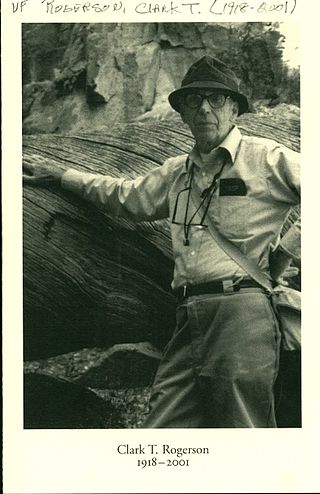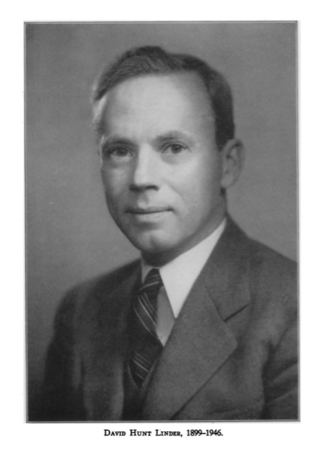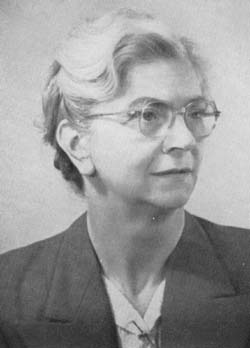Douglas Barton Osborne Savile was an Irish-born Canadian mycologist, plant pathologist and evolutionary biologist. He is particularly renowned for his unique work on the coevolution of host plants and their rust fungi.

A fungus is any member of the group of eukaryotic organisms that includes microorganisms such as yeasts and molds, as well as the more familiar mushrooms. These organisms are classified as one of the traditional eukaryotic kingdoms, along with Animalia, Plantae, and either Protista or Protozoa and Chromista.

Alexander Hanchett Smith was an American mycologist known for his extensive contributions to the taxonomy and phylogeny of the higher fungi, especially the agarics.
Gamsiella is a fungal genus in the Mortierellaceae family of the Zygomycota. The genus is monotypic, containing the single species Gamsiella multidivaricata, found in the United States.
Margaret Elizabeth Barr Bigelow (1923–2008) was a Canadian mycologist known for her contributions to the Ascomycetes fungi.

Clark Thomas Rogerson,, was an American mycologist. He was known for his work in the Hypocreales (Ascomycota), particularly Hypomyces, a genus of fungi that parasitize other fungi. After receiving his doctorate from Cornell University in 1950, he went on to join the faculty of Kansas State University. In 1958, he became a curator at The New York Botanical Garden, and served as editor for various academic journals published by the Garden. Rogerson was involved with the Mycological Society of America, serving in various positions, including president in 1969. He was managing editor (1958–89) and editor-in-chief (1960–65) of the scientific journal Mycologia.

Robert Lee Gilbertson was a distinguished American mycologist and educator. He was a faculty member at University of Arizona for 26 years until his retirement from teaching in 1995; he was a Professor Emeritus at U of A until his death on October 26, 2011, in Tucson, Arizona. 2011. He held concurrent positions as Plant Pathologist, Agricultural Experiment Station, University of Arizona (1967–95) for a project Research on wood-rotting fungi and other fungi associated with southwestern plants and was collaborator and consultant with Center for Forest Mycology Research, US Forest Service, Forest Products Laboratory, Madison, Wisconsin (1957–1981).
Gladys Elizabeth Baker was an American mycologist, teacher, and botanical illustrator, known for her extensive work in biological and mycological education, and the morphological study of myxomycete fructifications. She further contributed studies to the Island Ecosystems Integrated Research Program of the U. S. International Biological Program.
William Henry Weston Jr. (1890–1978) was an American botanist, mycologist, and first president of the Mycological Society of America. Weston was known for his research in the fungal group known as the phycomycetes, particularly the pathogenic genus Sclerospora.

David Hunt Linder (1899–1946) was an American mycologist known for his work on the Helicosporous fungi and his dedications for the advancement of mycological knowledge. He curated the Farlow Herbarium of Cryptogamic Botany at Harvard University and founded a highly respected journal Farlowia.
Lois Hattery Tiffany (1924–2009) was a mycologist who taught for over 50 years at Iowa State University (ISU) and was known as "Iowa's mushroom lady". She won a number of awards, including becoming the first recipient of both the Mycological Society of America's Weston Award and the Iowa Governor’s Medal for Science Teaching. She published on many different aspects of fungal life, but her special area of research was Iowa's prairie fungi.
Robert W. Lichtwardt was a Brazilian-born American mycologist specializing in the study of arthropod-associated, gut-dwelling fungi (trichomycetes). He is known for his online monograph and interactive keys to trichomycete taxa.

Constantine John Alexopoulos was an American mycologist. He was the main author of the landmark book Introductory Mycology, commonly used in mycology and mycology-related courses in undergrad and grad schools around the globe. Introductory Mycology was translated into five languages.
Frank Dunn Kern was an American plant pathologist and university administrator. He was a faculty member at Pennsylvania State University, holding appointments as Head of the Department of Botany and Dean of the Graduate School. He was an expert on the Pucciniales.

Lilian Edith Hawker was a British mycologist, known for her work on fungal physiology, particularly spore production. She was an expert on British truffles, and also published in the fields of plant physiology and plant pathology. She was also known for her contributions to education in mycology. Most of her career was spent at the botany department of the Imperial College of Science and Technology (1932–45) and the University of Bristol (1945–73), where she held the chair in mycology (1965–73) and was dean of the science faculty (1970–73). She served as president of the British Mycological Society, and was elected an honorary member of that society and of the Mycological Society of America. She published an introduction to fungi and two books on fungal physiology, of which Physiology of Fungi (1950) was among the first to survey the field, and also co-edited two microbiology textbooks.

Chester Wilson Emmons was an American scientist, who researched fungi that cause diseases. He was the first mycologist at the National Institutes of Health (NIH), where for 31 years he served as head of its Medical Mycology Section.
A. Elizabeth "Betsy" Arnold is an American evolutionary biologist who is Professor of Plant Sciences and Curator of the Robert L. Gilbertson Mycological Herbarium at the University of Arizona. Her research considers fungal biology. She was elected Fellow of the American Association for the Advancement of Science in 2021.
Amy Yarnell Rossman is an American mycologist and a leading expert in identifying fungi.
Lewis Edgar Wehmeyer was an American botanist and mycologist. He gained an international reputation as an expert on the genera Pleospora and Pyrenophora.
Dennis Edmund Desjardin is an American mycologist. He has been called the "Mushroom Guru of the West Coast".








